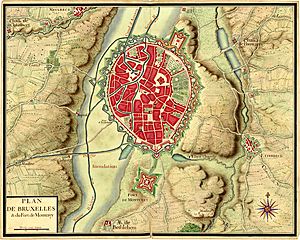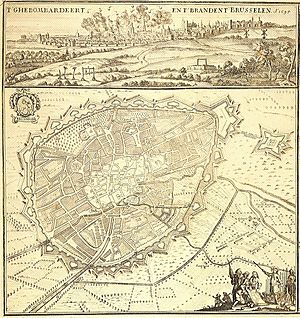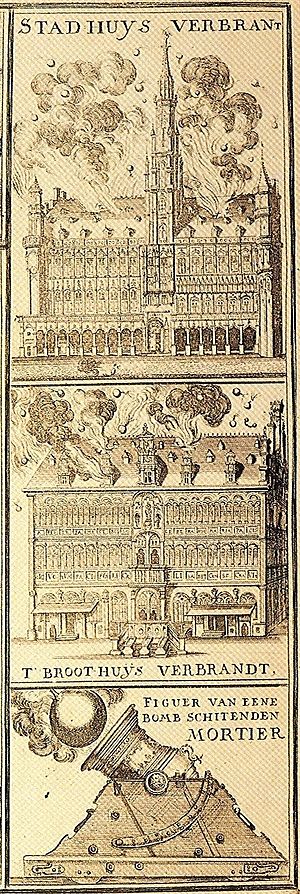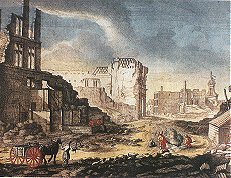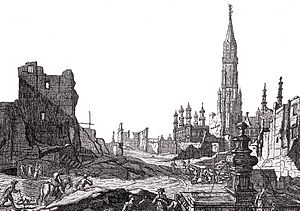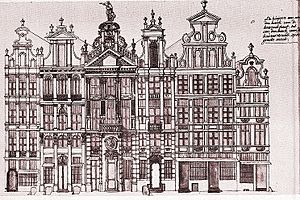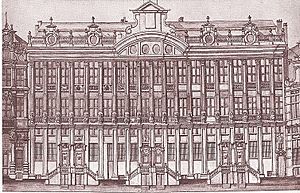Bombardment of Brussels facts for kids
Quick facts for kids Bombardment of Brussels |
|||||
|---|---|---|---|---|---|
| Part of the Nine Years' War | |||||
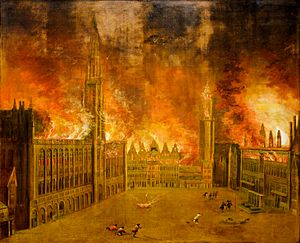 A 1695 painting of the bombardment |
|||||
|
|||||
| Belligerents | |||||
| Commanders and leaders | |||||
During the Nine Years' War, the French Royal Army attacked Brussels. This event, known as the bombardment of Brussels, happened from August 13 to 15, 1695. French forces, led by King Louis XIV and the Duke of Villeroi, bombed the city. Their goal was to make the Grand Alliance move their troops. They hoped this would stop the Alliance from helping in the siege of Namur.
The bombardment was the most damaging event in the history of Brussels. It destroyed about one-third of the city's buildings. This included the famous Grand-Place. After the attack, Brussels was rebuilt. This changed how the city looked forever. Even though the French caused a lot of damage, their plan failed. The Grand Alliance did not move their troops from Namur. King Louis XIV's reputation also suffered because of the destruction.
Contents
Why Did the Bombardment Happen?
The 17th century was a time of many wars for the Southern Netherlands. Large armies often marched through the region. This caused a lot of destruction. In 1695, France wanted to expand its territory. It slowly took over Spanish lands to its north. This led to many wars and changing alliances.
The Nine Years' War had been going on since 1688. France was fighting a large group of European countries called the Grand Alliance. Their leader was William III of Orange, who was also the leader of the Netherlands and soon to be King of England. Other members included Spain, Sweden, the Holy Roman Empire, and several rulers like Maximilian II Emanuel, Elector of Bavaria. Maximilian was the governor of the Spanish Netherlands.
In July 1695, the city of Namur was under French control. King William III and the allied army started a siege to take it back. The French army was led by the Duke of Villeroi. He was not a great military leader but was close to King Louis XIV. The King was upset about the siege of Namur. He told Villeroi to attack other cities like Bruges or Ghent. Villeroi suggested bombing Brussels instead. He thought this would force the enemy to come to Brussels, where the French could then attack them.
The Bombardment of Brussels
Getting Ready for the Attack
In late July, Villeroi asked the King for supplies. He needed many cannons, mortars, cannonballs, and explosive shells. He also needed a lot of gunpowder and wagons for transport. These supplies and troops came from French bases nearby. On August 7, Villeroi left Mons for Brussels. He had a huge supply train with him.
Villeroi wanted the allied armies at Namur to know his plans. He hoped to worry them. On August 3, a short break was called in the siege of Namur. This was to treat the wounded and get more supplies. After six days, the siege started again. William III and Maximilian II Emanuel stayed at Namur. Only a small army led by the Prince of Vaudemont tried to stop Villeroi. But his 15,000 men were too few against Villeroi's much larger force.
The French army reached Brussels on August 11. They set up their positions on high ground west of the city. Brussels was not well defended. Its old walls were not strong enough. The French easily took two small forts near the city gates. Then, they set up their artillery there.
On August 13, Villeroi sent a letter to Philippe François de Berghes. He was the military governor of Brussels. Villeroi claimed the bombing was revenge. He said it was for English attacks on French cities. He also asked where Max Emanuel's wife was. She was the daughter of the Polish King and was neutral in the war. The French King did not want her to be harmed.
The Prince of Berghes asked for more time. He wanted to ask William of Orange to stop attacking French cities. He also said it was unfair to punish Brussels for something the English King did. Villeroi refused, saying he had no power to make a deal with William of Orange.
How the Bombardment Affected the City
The French cannons started firing just before 7 PM. The first bombs hit houses, which quickly caught fire. The fire spread fast through the narrow streets. Many houses and workshops were partly made of wood, making them burn easily.
Brussels had only three small defense points. They tried to fire back, but they had little gunpowder or ammunition. The few shots they fired killed about 35 French soldiers. But they could not stop the bombing.
City leaders thought they could stop the fire. They told people to stay home with buckets of water. But this was useless. Panicked residents tried to save their belongings. They fled to higher parts of the city, away from the valley. A helpless crowd watched the fire from the ducal palace park. By midnight, the city center was burning. This included the stone buildings of the Grand-Place and its surroundings. The Town Hall was abandoned. Its tall spire was used as a target by the French. The Breadhouse also burned. Max Emanuel quickly returned from Namur. He tried to organize a defense against the fire and keep order.
On the morning of August 14, the bombing stopped. The French needed to resupply their cannons. Rumors spread that the French would choose new targets. In the confusion, people moved their belongings to areas already hit. These items were then destroyed when the bombing started again.
When the bombing restarted, it was even worse. More areas were hit. To the north, the Mint and the Dominican convent were attacked. Many valuable items and old records were lost there. To the east, people feared the St. Michael and Gudula Cathedral would be destroyed. Its treasures were moved to safety. The area around the Brussels-Central railway station and the Chapel of Mary Magdalene burned. The Récollet convent was almost completely destroyed. The Saint John Hospital was hit, and later, the Church of the Chapel.
By the morning of August 15, the entire city center was a huge fire. To save the rest of the city, Max Emanuel used gunpowder. He blew up many buildings to create a giant firebreak. This stopped the fire from spreading, even though many owners did not want their buildings destroyed. The French stopped firing around midday, after 48 hours of bombing.
The Damage Caused
Because people had time to escape, few people died in the bombing. However, some records show a man killed in the first attack. Two monks died under their convent's ruins. Four patients burned alive in Saint John Hospital. People trying to save their things and even looters were buried under the rubble.
A local artist named Augustin Coppens recorded the damage. His own house was destroyed. He made detailed drawings of his hometown's destruction. These drawings were later published and show how much was lost.
Constantijn Huygens, a Dutch official, visited Brussels. He wrote in his diary that the destruction was "horrible." He said many houses were "reduced to rubble." The cultural and material losses were huge. About 4,000 to 5,000 buildings were destroyed. This was about one-third of all buildings in the city. In the city center, almost every building was destroyed.
The rubble was so deep it covered the streets. Wooden houses were mostly burned away. Only stone and brick buildings like public buildings and churches survived.
Brussels' artistic treasures, built up over centuries, were badly damaged. Many artworks inside the destroyed buildings were lost. This included Brussels tapestries, furniture, and paintings by famous artists like Rogier van der Weyden, Rubens, and Anthony van Dyck. Much of the city's history was also lost. A large part of its historical records was destroyed.
Experts estimated the property losses were very high. One estimate was about 50 million florins. This would be billions of euros today.
What Happened Next?
The French themselves were surprised by how much damage they caused. Villeroi wrote that the destruction was "incredible." The French artillery master said he had never seen such a large fire. The young Duke of Berwick, a future French general, called it "a more appalling spectacle." He said it was like the sack of Troy.
Many people across Europe condemned the attack. It went against the rules of war at the time. Bombings were supposed to target defenses, not civilians. The Grand Alliance leaders met and promised to get revenge for Brussels. The bombing did not make the Allies leave Namur. Namur surrendered on September 5. But the attack badly hurt King Louis XIV's reputation. Napoleon later called the bombardment "barbarous and useless."
Some historians believe the bombardment changed military tactics. Before, taking forts was key. This attack showed that strong towns could not stand against modern firepower. This led to less siege warfare and more direct battles.
Rebuilding Brussels
First Steps to Rebuild
Right after the bombing, city leaders started to fix things. They made rules to deal with the urgent problems and begin rebuilding. The central government and the local city government (called the Magistracy) shared power. This caused some disagreements, making things harder.
Getting supplies to the city was a big problem. But nearby cities helped within a few days. Merchants were told not to bring commercial goods or beer into Brussels. This freed up transport for supplies. Brussels asked other cities in Brabant, like Leuven, Antwerp, and Mechelen, for help. They sent food convoys right away.
Many residents had no homes. They camped in the palace park. Authorities found temporary shelters. Rent increases were not allowed. To stop looting and bring back order, the city formed citizen militias. These groups patrolled the damaged areas. Max Emanuel also posted guards day and night.
It took several months to clear the rubble. Everyone had to help. People had to provide wagons and horses. Some were forced to work. To speed up rebuilding, rules were relaxed. Foreign workers could come to the city and work freely for two years. But they could not ask for higher wages than before the bombing. The governor allowed building supplies to enter the city for free. Prices were frozen for two years. By opening Brussels to outside trade, the old guilds' control was lessened. This helped the city return to normal faster.
Two Ideas for the City
A few months after the bombing, two different ideas for the city appeared. The governor, Maximilian II Emanuel, elector of Bavaria, wanted to use the rebuilding to change the city's layout and style. He was an ambitious ruler. He dreamed of making the Spanish Netherlands his own state. He wanted to turn the medieval city into a new baroque style city. He had seen this style in Vienna and Turin. Turin had straight streets and uniform buildings. Max Emanuel wanted buildings and streets to be built in a uniform way to make the city more beautiful.
But the people of Brussels had different priorities. They needed to rebuild quickly so their businesses could start again. They also wanted to stop people from leaving the city. The city leaders had little money. They could not afford grand plans. Spain and the governor could not give money because they needed it for the war. So, the solution was to be careful with money and be effective. They decided to reuse materials and old foundations.
The residents and the guilds did not like the idea of a new, foreign style. Local builders and artists understood the local materials and needs better. They could still make beautiful buildings, even if they were not baroque. The central government was weak, and the governor was away fighting the war. So, the city's structure stayed mostly the same. This was similar to what happened after the Great Fire of London in 1666.
After the War of the Spanish Succession started in 1701, Max Emanuel left his post as governor. He then sided with France in the war. His grand plans for Brussels were not carried out. What he did build was mostly to show his power. He ordered the building of the first Theatre of La Monnaie. He also wanted to rebuild the Grand-Place with a uniform look. But this was only done on one side of the square, now called the House of the Dukes of Brabant.
Rebuilding the City Center
Even though the city's general layout stayed the same, it was not exactly identical. Despite needing to rebuild fast and having little money, leaders made some improvements. They wanted to improve traffic flow, cleanliness, and the city's look. Many streets were made wider for better traffic. New rules were made to stop cellar doors, steps, and goods from blocking the street.
Old rules against thatched roofs, wooden canopies, and upper floors sticking into the street had not been enforced. Now, any building that did not follow the rules had to be torn down.
The rebuilding of the Grand-Place and nearby streets was very important. This area was the city's political and economic heart. The city government paid for the repair of the Town Hall. They raised money by selling houses and land. Guilds were encouraged to rebuild their guildhalls with great care. Every plan needed approval from the Magistracy.
Even though the guilds' power was decreasing, they spent a lot of money decorating their guildhalls. They often went into debt for decades to do so. It was important to keep a strong resemblance to the old buildings. The guildhalls were rebuilt using many different styles. But they still looked remarkably harmonious together. They combined Gothic, Baroque, and Louis XIV styles. Five years after the disaster, Brussels was almost completely rebuilt. It was even more beautiful than before the fire. The rebuilding happened very quickly. People hoped for lasting peace after the fall of Namur and the Treaty of Ryswick. Both events were celebrated greatly in the city.
See also
 In Spanish: Bombardeo de Bruselas para niños
In Spanish: Bombardeo de Bruselas para niños



